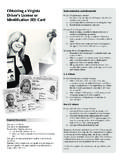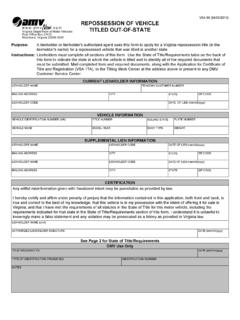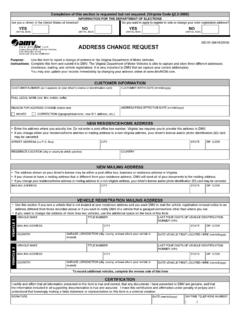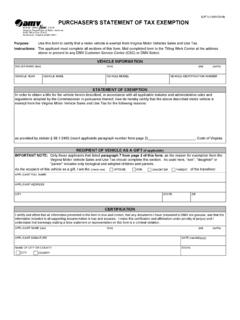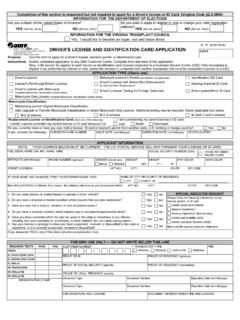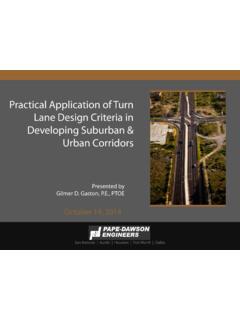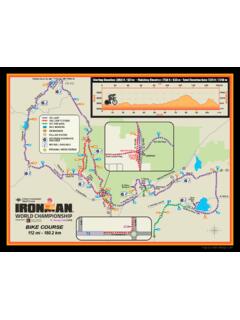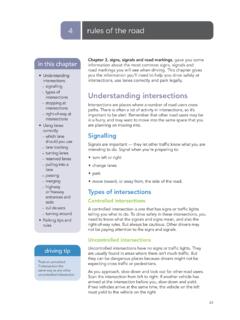Transcription of You may turn left at a red light if you are on Pavement ...
1 VIRGINIA DRIVER S MANUAL | 5In this section you ll learn about: Traffic signals Traffic signs Pavement markings Painted curbsTraffic signals, signs and Pavement markings are used for traffic control to provide a smooth, orderly flow of traffic. It is important to understand and obey them. It is illegal to avoid these traffic controls by cutting through a parking lot or field. Obey all signs and signals unless directed by a police officer; always follow the officer s Signals Traffic signals apply to drivers, motorcycle riders, bicyclists, moped-riders and light : At a red light , come to a complete stop at the stop line or, if there is no stop line, before entering the intersection or before reaching the crosswalk.
2 Remain stopped as long as the signal is red, unless turns are turn on red: You may turn right while the traffic signal displays a red light . Before turning, you must come to a complete stop. Look both ways and yield the right-of-way to pedestrians and other traffic. Be sure to check for less visible vehicles such as motorcycles, bicycles and mopeds. Section 2: Signals, Signs and Pavement MarkingsYou may not turn right on red if signs are posted at the intersection that read No turn on Red, or if a red arrow pointing to the right is displayed. Left turn on red: You may turn left at a red light if you are on a one-way street and turning left onto another one-way street while the traffic signal displays a red light . Before turning, you must come to a complete stop. Look both ways and yield the right-of-way to pedestrians and other traffic.
3 Be sure to check for less visible vehicles such as motorcycles, bicycles, and mopeds. You may not turn left on red if signs are posted at the intersection that read No turn on Red, or if a red arrow pointing to the left is displayed. Red arrow: A red arrow means you must stop if you intend to move in the direction of the arrow. You may not proceed in the direction of the arrow as long as the red arrow is displayed, unless signs are posted at the intersection that read Right on Red Arrow After Stop or Left on Red Arrow After Stop. Virginia law prohibits right and left turns at red arrow lights. Note: If you are traveling in another state, make sure you know its laws for right and left turns at red and red arrow lights. Flashing red light : At a flashing red light , come to a complete stop and yield to oncoming vehicles and pedestrians.
4 You may go when the way is clear. At a railroad crossing, you must come to a complete stop even if you don t see a red arrow: At a flashing red arrow, come to a complete stop, yield the right-of-way to vehicles coming from the other direction and pedestrians in the intersection, and proceed in the direction of the arrow when the way is light or arrow: A yellow light or arrow are cautions warning that the light is about to change. If you have not entered the intersection, stop; or, if unsafe to stop, cautiously go through it. If you are already in the intersection, go through it cautiously. Do not speed up to beat the yellow light : A flashing yellow light means slow down and proceed with caution. Flashing yellow lights are at locations with higher-than-normal hazardous yellow arrow: At a flashing yellow arrow, you may turn in the direction of the arrow, if the way is clear.
5 Yield the right-of-way to vehicles coming from the other direction and pedestrians in the intersection. Be sure to check for less visible vehicles such as motorcycles, bicycles, and mopeds. If a traffic light changes from red to flashing yellow arrow while a pedestrian is in the intersection, allow the pedestrian to cross the street before turning. 6 |VIRGINIA DRIVER S MANUALS ection 2: Signals, Signs and Pavement MarkingsGreen light or arrow: At a green light , you may go if the way is clear. At a green arrow, you may go in the direction of the arrow if the way is clear. If you are turning without a green arrow, you must yield the right-of-way to vehicles coming from the other direction and pedestrians in the intersection. Be sure to check for less visible vehicles such as motorcycles, bicycles, and mopeds.
6 If a traffic light changes from red to green while a pedestrian is in the street, allow the pedestrian to cross the street before of service signals: When traffic signals are not working because of a power outage or other problem and not displaying any lights, you are required to stop, proceeding through the intersection as though it were an all-way stop. This does not apply if a law enforcement officer or other authorized person is directing traffic at the intersection, or if portable stop signs are in use signals indicate lanes where you can and cannot drive during different hours of the day. Red X: Never drive in a lane marked with a red X X or Yellow Diagonal Downward Arrow: These signals mean that you should move out of the lane as soon as safely Arrow: You are permitted to drive in a lane marked with a green arrow Arrow: You are permitted to enter in a lane marked with a one-way or two-way arrow only to turn in the direction of the SignsThe color and shape of a traffic sign communicates important information about the sign s message.
7 In poor visibility conditions, such as heavy fog, you may be able to make out only the shape of a sign. As you approach a sign and while still distant, you may see the color long before you can read the message or see the symbol, giving you some advance Colors Sign colors help you know what the intention of the sign used with white conveys stop, yield, do not, and no. Stop signs, yield signs, do not enter or wrong way signs, the circle and slash in a no turn sign, and the restrictions in a parking sign are used with white conveys regulatory information. Speed limit, do not pass, no turns are examples where the operation is regulated by law and the black and white sign would be used with black conveys a warning. Curve ahead, stop ahead, overhead clearances, slippery when wet, are all examples.
8 A specialized class of warning signs uses a strong yellow/green color with black to advise of school zone, pedestrian and/or bicyclist and white, blue and white, and brown and white signs are used to provide helpful information. The green sign is used to provide destination types of information, while the blue sign is used to inform regarding motorists services. The brown sign is used to advise of historical or cultural interests that might exist in the and black and pink and black signs are used to advise and warn in construction (orange) and incident (pink) areas. They are used with black and white signs that convey regulations that might exist only because of the construction effort or the ShapesOctagon (Stop): This eight-sided shape always means stop. You must come to a complete stop at the sign, stop line, pedestrian crosswalk or curb.
9 Wait for any vehicle or pedestrian to clear the way. At some intersections you ll find a sign beneath the stop sign that reads All Way or 4 Way. At these intersections all vehicles on all roads leading into the intersection must stop. If you get to the intersection at the same time as other vehicles, the driver on the left must yield to the driver on the (Yield): You must slow down as you come to the intersection. Be prepared to stop. Let any vehicles, pedestrians or bicyclists safely pass before you (Regulatory or Guide): Vertical signs generally give instructions or tell you the law. Horizontal signs may give directions or DRIVER S MANUAL | 7 Diamond (Warning): These signs warn you of special conditions or hazards ahead. Slow down and drive with caution. Be ready to (School Zone/School Crossing): This five-sided shape marks school zones and warns you about school crossings.
10 Two signs may be used together to show the actual location of the crosswalk. Regulatory signs inform you of the law; you must obey their instructions. Remember that a red circle with a slash means NO the symbol inside the circle tells you what is prohibited. Speed Limit: These signs tell you the maximum legal speed that you may drive on the road where the sign is posted when weather conditions are good. Some roads have electronic speed limit signs that change based on weather or traffic conditions. During rain, snow and ice, you may receive a ticket for driving too fast for the conditions even if you are driving at or less than the posted speed limit. Do Not Enter Wrong Way: These signs mean you cannot drive in that direction. If you drive past these signs you are going in the wrong direction and could get into a head-on crash with vehicles headed your way.
